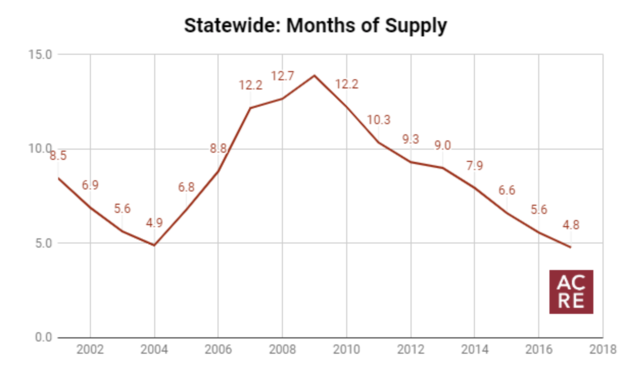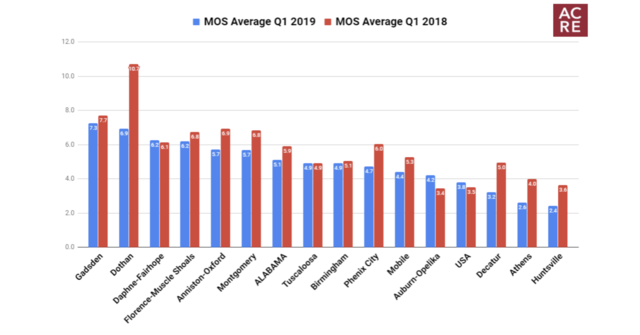Alabama’s residential market is driven to a large degree by inventory, the amount of homes listed for sale at any given moment. Inventory* levels impact months of supply, an important metric used to determine whether it’s a buyer’s or seller’s market. Sales prices are also heavily influenced by inventory levels. In the lead up to the Great Recession, for example, inventory was abundant and seller’s competed with one another for a limited number of buyers. Not surprisingly, this was one factor that lead to declining home values from 2007 to 2011 when the statewide median sales price declined 8.5 percent. Alabama’s residential market today is quite different, mostly because inventory levels have been tight for several years now, while total sales are at record levels. According to the Center’s most recent Statewide Annual Report, the average number of homes on the market peaked in 2008 with approximately 41,200 listings. From that peak, inventory consistently trended downwards with approximately 23,600 listings in 2018, a decline of 42.8 percent from peak levels. That slow yet important shift in the number of homes on the market has many implications: homes selling faster and at higher prices.

One of the better metrics for understanding residential markets is inventory to sales ratio, also called months of supply (MOS). When the statewide median sales price bottomed out in 2010 there were 13.9 MOS. Compare that to 4.9 MOS in 2005 and 4.8 MOS currently. Most real estate professionals consider 6 months of supply to be the equilibrium point, where buyers and sellers have roughly equal bargaining power. It comes as no surprise that median sales prices declined 8.5 percent as the market shifted from 4.9 MOS in 2005 to 13.9 MOS in 2010. What is surprising, however, is that prices did not fall even more.

After steadily declining for several years, inventory nationwide is now trending back up, increasing 3 percent year-over-year (y/y) during the first quarter of 2019. Only two of Alabama’s 14** metropolitan areas witnessed y/y inventory gains during the same period: Auburn-Opelika and Daphne-Fairhope-Foley. Inventory gains in both areas are driven in part by strong new construction markets. New construction represented 29.4 percent of all residential sales in Auburn-Opelika and 21.4 percent in Daphne-Fairhope-Foley.
As mentioned earlier, inventory statewide is trending downwards, declining 9.9 percent y/y in the first quarter of 2019. This extends the streak of statewide year-over-year inventory declines to 49 consecutive months, a trend that began in March 2015. Inventory shortages are most extreme in the north Alabama region, dropping 30 percent y/y in Huntsville and Decatur and 25 percent in Athens. A strong regional economy, combined with steady population and job growth, have spurred demand for housing in the area. Other markets seeing significant inventory declines in the first quarter include Dothan (down 21 percent), Anniston-Oxford-Jacksonville (down 15 percent), and Mobile (down 13 percent). Mobile also has the state’s longest streak of year-over-year inventory declines (65 consecutive months), a trend that began in November 2013.
The chart below shows Alabama’s metropolitan areas ranked by months of supply during the first quarter. Strong seller’s markets include Huntsville (2.4 MOS), Athens (2.6), Decatur (3.2) Auburn-Opelika (4.2), and Mobile (4.4). Buyer’s markets include Gadsden (7.3), Dothan (6.9), Daphne-Fairhope-Foley (6.2) and Florence-Muscle Shoals (6.2). Stay tuned to see if inventory continues to tighten as the summer months near, creating great conditions to sell but also creating challenges for people wanting to enter the market, especially first time buyers.






